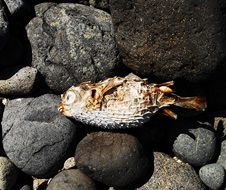How can we be sure it's not pollution or a chemical spill?
Chris Doyle, acting Senior Team Leader, Environmental Forensics and his team have undertaken detailed analyses of water samples following an event like the recent one in the Parramatta River. Mr Doyle said there are other possible causes of fish kills such as chemical spills and other types of pollution that can result in the loss of dissolved oxygen – such as sewage and industrial pollutants like organic solvents.
"In the Parramatta River, we conducted a raft of tests to make sure there was no indication that chemical or sewage pollution caused this recent fish kill," Mr Doyle said. "From this testing, we can rule things out and narrow down the investigation as we go. We have found no evidence of pollution that could have caused this event."
His team even ran tests in the laboratory using captive crustaceans and bacterial colonies exposed to Parramatta River water samples.
"Neither of them gave any indication of pollution or contaminants. After a fish kill like this, it's not just one test and that's it. We look at many things so we can understand what has happened."
Can blackwater events be prevented?
While blackwater events occur even in undisturbed, natural systems, Dr Scanes said the fact that the Parramatta River catchment is so urbanised means that vegetation is quickly moved into the river by concrete drains and hard surfaces. So when a perfect alignment of extreme tides, warm weather, and heavy rain occurred, a hypoxic blackwater event in the Parramatta River was the result.
"We need more water sensitive urban design," Dr Scanes said. "We need to retain water in the landscape and slow it down as it moves towards estuaries and rivers."
For example, he said new developments often require stormwater retention areas that look like lakes. "These act as artificial wetlands slowing water down and allowing the organic matter to be filtered by wetland plants".
Do waterways recover after a blackwater event?
Dr Scanes said most of the fish probably left the areas where the blackwater event took place in the Parramatta River.
"Fish aren't silly. They are well adapted to live in aquatic environments, and when they sense low oxygen and have difficulty breathing, they leave. They will return in time. The most impacted species were those that dwell close to the bottom – bream, flathead, and whiting and although we saw a lot of dead fish, it probably represents just a small proportion of the number of fish that were there.
"Changes in tides, fresh water moving out of the system, and the gradual breakdown of organic debris will see the river return to pre-blackwater conditions and the fish return, but for rivers like the Parramatta where our research shows low oxygen states are common, there is always the possibility that these factors will again align and culminate in another blackwater event in the future, but positive changes in recycling organic waste by the community significantly lessens this risk.







